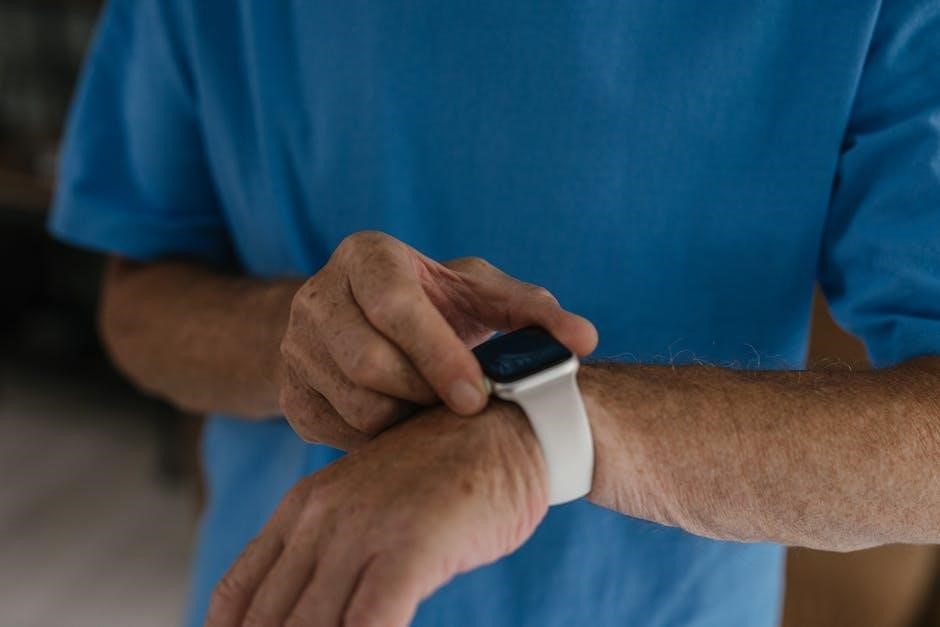smartwatch user manual

Smartwatch User Manual: A Comprehensive Guide
Welcome to the ultimate resource for mastering your smartwatch! This guide provides detailed instructions for setup, features, and troubleshooting. Whether you’re a tech novice or an experienced user, this manual will help you maximize your smartwatch experience. Explore functionalities, understand settings, and resolve common issues.
Your smartwatch is more than just a time-telling device; it’s a sophisticated extension of your smartphone, designed to enhance your daily life. This comprehensive user manual aims to guide you through every aspect of your smartwatch, from initial setup to advanced features. By understanding its capabilities, you can seamlessly integrate it into your routine for improved convenience, health tracking, and communication.
Smartwatches combine the functionality of a traditional timepiece with the power of modern technology. They offer a range of features, including fitness tracking, notifications, communication tools, and access to various apps. Understanding how to navigate and utilize these features effectively is crucial for maximizing the value of your device.
Before diving into the specifics, it’s essential to familiarize yourself with the basic components and functionalities of your smartwatch. This includes understanding the different buttons, touchscreen gestures, and charging methods. By taking the time to learn these fundamentals, you will be well-equipped to explore the more advanced features and customize your smartwatch to suit your personal needs and preferences. This manual will be your constant companion as you embark on this technological journey.

Initial Setup and Activation
Getting your smartwatch ready for use involves a few essential steps to ensure it’s properly configured and connected. First, unpack your smartwatch and inspect all included accessories, such as the charging cable and any additional straps. Ensure everything is in good condition before proceeding. Next, it’s crucial to fully charge your smartwatch. Connect the charging cable to the device and plug it into a power source. Allow it to charge until the battery is at 100%, as this will optimize its lifespan.
While your smartwatch is charging, download the corresponding smartwatch application onto your smartphone. This app is usually available on the Google Play Store for Android devices or the App Store for iPhones. Once downloaded, install the application and prepare to pair your smartwatch.

After the smartwatch is fully charged, turn it on by pressing and holding the power button. On your smartphone, open the smartwatch application and follow the on-screen instructions to pair your device. This usually involves enabling Bluetooth on your phone and selecting your smartwatch from the list of available devices. Once paired, the app may prompt you to update the smartwatch’s firmware. It is highly recommended to complete this update to ensure optimal performance and security.
Navigating the User Interface
Understanding the user interface of your smartwatch is essential for efficient and enjoyable usage. Most smartwatches feature a touchscreen display, often accompanied by one or more physical buttons for navigation. The primary screen typically displays the watch face, which can usually be customized to show various information such as time, date, battery level, and more.
Swiping on the touchscreen is the most common method for navigating through different menus and options. A swipe down from the top of the screen usually reveals quick settings, allowing you to adjust brightness, toggle Bluetooth, and activate features like do-not-disturb mode. Swiping up from the bottom of the screen often displays notifications, providing a summary of incoming messages, emails, and alerts.
Swiping left or right typically cycles through different widgets or app shortcuts. These widgets provide quick access to features like heart rate monitoring, weather updates, and music controls. Pressing the physical buttons can serve various functions, such as returning to the home screen, accessing the app drawer, or activating specific features like the voice assistant. Familiarize yourself with the button layout of your smartwatch to streamline your interactions. Additionally, explore the settings menu on your watch to customize the user interface to your preferences, adjusting font sizes, display settings, and notification preferences.
Connecting to Your Smartphone
Establishing a connection between your smartwatch and smartphone is crucial for unlocking the full potential of your wearable device. The initial connection process usually involves downloading the companion app provided by the smartwatch manufacturer from your smartphone’s app store (e.g., Google Play Store for Android or Apple App Store for iOS). Once the app is installed, launch it and follow the on-screen instructions to pair your smartwatch.
Typically, this involves enabling Bluetooth on both devices and allowing the app to search for nearby smartwatches. When your smartwatch appears in the app, select it to initiate the pairing process. You may be prompted to enter a pairing code displayed on your smartwatch to confirm the connection. Once paired, the app will guide you through setting up various preferences, such as notification settings, health tracking permissions, and app synchronization.
A stable Bluetooth connection is essential for receiving notifications, making calls, and syncing data between your smartwatch and smartphone. Ensure that Bluetooth is enabled on both devices and that they are within a reasonable range of each other. Some smartwatches also support Wi-Fi connectivity, allowing them to connect to your home network and access online services independently of your smartphone. Consult your smartwatch’s user manual for specific instructions on connecting to Wi-Fi. Properly connecting your smartwatch to your smartphone ensures seamless communication and access to a wide range of features.
Key Features and Applications
Smartwatches boast a diverse array of features and applications, enhancing various aspects of daily life. One of the primary functions is notification management, allowing users to receive alerts for calls, messages, emails, and social media updates directly on their wrist. This eliminates the need to constantly check a smartphone, providing a convenient and discreet way to stay connected.
Fitness tracking is another prominent feature, with smartwatches equipped with sensors to monitor heart rate, steps taken, distance traveled, and calories burned. Many devices also offer specialized tracking for various workout activities, such as running, cycling, and swimming. Sleep monitoring is commonly included, providing insights into sleep patterns and quality.
Beyond health and communication, smartwatches offer a range of applications. Music playback allows users to control music from their smartphone or stream directly to the watch. GPS functionality enables navigation and location tracking. Contactless payments are supported via NFC, allowing for convenient transactions. Voice assistants like Siri or Google Assistant are integrated for voice commands and information retrieval. Additional apps can be downloaded to expand functionality, including productivity tools, games, and smart home controls. The versatility of smartwatches makes them valuable companions for both personal and professional use, offering a blend of convenience, information, and entertainment on your wrist.
Health and Fitness Tracking
Smartwatches have revolutionized personal health and fitness tracking, offering a comprehensive suite of tools to monitor various aspects of well-being. At the heart of these capabilities lies the heart rate sensor, continuously tracking your pulse throughout the day and during workouts, providing valuable insights into cardiovascular health. Step tracking is another fundamental feature, counting your daily steps to encourage an active lifestyle and help you achieve your fitness goals.
Many smartwatches go beyond basic metrics, offering advanced features like sleep monitoring. This function analyzes your sleep patterns, tracking the duration of different sleep stages (light, deep, REM) to provide a comprehensive overview of your sleep quality. Some devices also include blood oxygen (SpO2) monitoring, which measures the oxygen saturation in your blood, an important indicator of respiratory health.
For fitness enthusiasts, smartwatches offer specialized workout tracking modes for various activities like running, cycling, swimming, and more. These modes track metrics specific to each activity, such as distance, pace, and elevation gain. GPS integration allows for accurate tracking of outdoor workouts, mapping your route and providing detailed performance data. With these tools, smartwatches empower users to take control of their health and fitness, providing the data and insights needed to make informed decisions and achieve their wellness goals.
Customizing Watch Faces and Settings
Personalizing your smartwatch enhances its utility and reflects your unique style. Customizing watch faces is a key aspect, allowing you to select from a variety of designs, from classic analog displays to modern digital interfaces. Many smartwatches offer pre-installed watch faces, while others allow you to download additional options from app stores. Some even let you create your own watch faces, incorporating personal photos or specific data displays.
Beyond aesthetics, customizing settings optimizes your smartwatch experience. Notification management is crucial, enabling you to choose which apps can send alerts to your wrist. You can prioritize important notifications and filter out less relevant ones, minimizing distractions. Display settings allow you to adjust brightness, font size, and screen timeout, ensuring optimal visibility and battery life.
Sound and vibration settings let you personalize how your smartwatch alerts you. You can choose different ringtones and vibration patterns for various notifications, making it easier to identify alerts without looking at the screen. Accessibility settings cater to users with specific needs, offering features like text-to-speech, screen magnification, and customizable button functions. By tailoring these settings to your preferences, you can create a smartwatch experience that is both functional and enjoyable.
Troubleshooting Common Issues
Smartwatches, like any electronic device, can occasionally encounter issues. Addressing these problems promptly ensures continued functionality. One common issue is connectivity problems. If your smartwatch fails to connect to your smartphone, ensure Bluetooth is enabled on both devices and that they are within range. Restarting both devices can often resolve temporary glitches. Check for software updates, as outdated firmware can cause compatibility issues.
Battery drain is another frequent concern. To extend battery life, reduce screen brightness, disable unnecessary notifications, and limit the use of power-intensive features like GPS. If the battery drains rapidly even with minimal use, consider a factory reset or contacting customer support, as it may indicate a hardware problem.
Touchscreen unresponsiveness can also be frustrating. Clean the screen with a soft, dry cloth to remove any dirt or smudges. If the issue persists, try restarting the smartwatch. In some cases, a software glitch may be the culprit, requiring a firmware update or a factory reset. If none of these steps resolve the issue, professional repair services may be necessary. By systematically addressing these common issues, you can keep your smartwatch functioning smoothly.
Battery Management and Charging
Efficient battery management is crucial for maximizing the usability of your smartwatch. Understanding how to optimize battery life and properly charge your device will significantly enhance your experience. Smartwatches typically use lithium-ion batteries, which benefit from consistent charging habits. Avoid frequently draining the battery to zero percent, as this can degrade its long-term capacity; Instead, aim to recharge when the battery level reaches around 20-30%.

When charging, use the charging cable and adapter specifically designed for your smartwatch. Using incompatible chargers can damage the battery or charging circuitry. Ensure the charging contacts are clean and free of debris to ensure a proper connection.
To extend battery life between charges, consider adjusting power-saving settings. Reduce screen brightness, shorten screen timeout durations, and disable unnecessary features like continuous heart rate monitoring or always-on display. Limiting the number of notifications and background app activity can also conserve power. Regularly monitor battery usage in the settings menu to identify power-hungry apps and adjust their usage accordingly. By implementing these strategies, you can optimize your smartwatch’s battery performance and enjoy extended usage times.
Safety Precautions and Maintenance
To ensure the longevity and safe operation of your smartwatch, adhere to the following precautions and maintenance guidelines. Avoid exposing your smartwatch to extreme temperatures, such as direct sunlight or freezing conditions, as these can damage the battery and internal components. Protect your device from impacts and drops, which can cause screen cracks or internal damage.

Clean your smartwatch regularly using a soft, lint-free cloth. Avoid using harsh chemicals or abrasive cleaners, as they can damage the surface and seals. If your smartwatch is water-resistant, rinse it gently with fresh water after exposure to sweat, saltwater, or other liquids. Ensure the device is completely dry before charging or storing it.
When not in use, store your smartwatch in a cool, dry place away from dust and moisture. Do not attempt to disassemble or repair the device yourself, as this can void the warranty and pose safety risks. If you encounter any issues, contact the manufacturer’s customer support for assistance. Regularly check for software updates to ensure optimal performance and security. By following these simple precautions and maintenance tips, you can keep your smartwatch in excellent condition and enjoy its features for years to come.
Advanced Features and Tips
Unlock the full potential of your smartwatch by exploring its advanced features and heeding these helpful tips. Dive into customizable settings to tailor your device to your specific needs and preferences. Experiment with gesture controls for quick access to frequently used functions. Explore the app ecosystem to discover tools that enhance productivity, fitness, and entertainment.
Utilize voice commands to control your smartwatch hands-free, making calls, sending messages, or setting reminders with ease. Take advantage of the built-in GPS for accurate location tracking during outdoor activities. Master the art of creating custom watch faces to reflect your personal style. Learn how to use NFC for contactless payments and other convenient interactions.
Optimize battery life by adjusting screen brightness, disabling unnecessary notifications, and limiting background app activity. Discover hidden shortcuts and Easter eggs that add a touch of fun to your smartwatch experience. Stay informed about the latest software updates to access new features and performance improvements. By embracing these advanced features and tips, you can transform your smartwatch into a powerful and versatile tool that enhances your daily life.
Leave a Reply
You must be logged in to post a comment.